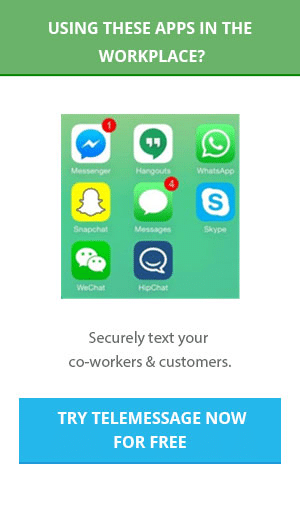
Over 135 billion text messages are sent every month. That’s almost 4.5 billion messages per day, and over 3 million messages per minute.
Americans are far and away the highest consumer of monthly data, spending the most time per day on their phones with a staggering 4.7 hours. Considering that the average American is awake for just over 15 hours a day, this means that we spend approximately a third of our time on our phones.
Workplaces embrace text messaging and group chat technologies
Just as text messaging, group chat, and collaborative messaging apps have become popular in the consumer space, they’ve also become widely used within the workplace as well. The rapid rise of these technologies has changed people’s expectations of communications within their personal sphere, and it’s no different in the workplace.
Unlike email, text messages usually receive a response within 90 seconds of being received. Users can also know whether recipients have received and read their messages or not. When collaborating on projects, real-time communication can be especially useful when decisions need to made quickly. Text messaging helps overcome the email overload that modern-day employees face, while improving team collaboration and completion of projects.

The unforeseen risks with workplace text messaging
With BYOD (Bring-Your-Own-Device) becoming more widespread, employees are embracing texting, group chat and other consumer apps such as WhatsApp, Google Hangouts, or iMessage for their work communication.
Surveys showed that 95% of employees send work related information over their smartphones, 75% send sensitive or confidential information, and only 13% reported to have regulations limiting the use of texting for work related tasks. What this means is that, while messaging has improved collaboration and productivity, it can also pose a huge security risk for the organisation.
Text messages function essentially the same way email does: your client (phone) forwards it to a server, which then looks up a destination which may be on another network (carrier) and then sends it over where it is held in a mailbox until a phone gets it. Messages are not encrypted at any point during this process and can be intercepted along the way.
Furthermore, text message contents’ can remain on a user’s phone indefinitely. Imagine if the phone is lost or stolen. Unfortunately, this is an all too common occurrence with and 68 percent of victims were unable to recover their device after the theft occurred (Note that 44 percent, of phone theft victims accidentally left their phone behind in a public setting where it was later snatched up by a thief). A stolen or lost phone could be a potential disaster for many businesses or organisations.
Employees are embracing consumer messaging apps, but IT administrators warn that the use of consumer messaging apps poses additional risks when users’ identities cannot be authenticated. Messages containing sensitive information could potentially be forwarded to a person or group outside the company and similarly, if an employee leaves the organisation, he or she might still be part of company group chats, and have access to company data within the app.
So if you’re using text messaging in the workplace, you might want to reconsider the app that you are using, especially if you work in healthcare, financial services, or government and public safety—industries that deal with highly sensitive and private data. Standard text messaging also is not compliant with HIPAA regulations, as well as several external financial compliance laws such as SOX, FINRA, and others, and failure to comply with those regulations could lead to hefty fines and even jail time.

Messaging services built for business gain momentum
The good news is that a new class of messaging services for workplaces is emerging. Technology giants have launched or honed business messaging services including Microsoft Corp.’s Yammer, Jabber from Cisco Systems, Hangouts, as well as a cadre of newcomers such as, Slack, HeyWire, Convo and TeleMessage have entered the market.
These applications offer secure text messaging while offering the ease of use, functionality and collaborative tools as in standard consumer apps.
Technology research firm Gartner, estimates half of team coordination and communication by 2018 will occur via group collaboration apps.
How does secure text messaging work?
Company administration allows provisioning of user accounts, creation of corporate address books and groups, allowing enforcement of corporate policies.
Security features such as end-to-end encryption, self-destructing messages, remote data wipe from lost devices or deactivated accounts.
Message delivery receipt allows users to know when their messages have been sent, delivered, read.
Message archiving and auditing controls for compliance and regulation purposes.
Most solutions include web/desktop interfaces allow back-office employees to communicate with the employees using their mobile apps outside of the office, for example. API integration of the solution into corporate IT systems such as databases, ERP, CRM, alert systems etc.

Expanding company messaging towards consumers and customers
According to Portio Research more than 2.1 billion people are using social messaging apps, and recent data from the Pew Research Center shows 36 of smartphone owners in the United States use at least one messaging app.
It seems like the next wave will be extending messaging apps for enterprise external communications for communicating securely between companies and their customers, allowing the sharing and exchange of personal sensitive information as well as bolstering the engagement with mobile authentication and transaction confirmations.
What does this mean for the future of messaging?
With the plethora of text messaging services, chat apps, and other group communication tools available, do we really need even more apps for the workplace?
The answer is a resounding a yes.
There’s no doubt that enterprise messaging apps meet the needs that the workplace requires, whereas consumer apps do not. Good communication is essential to the health of any organization, and with the increase in mobile workflows, and BYOD programs, this space will continue evolve in the next few years.
 Author: Gil Shapira Thursday, May 19, 2016[wp_social_sharing social_options=’facebook,twitter,googleplus,linkedin,pinterest’ twitter_username=’TeleMessage1′ facebook_text=’Share on Facebook’ twitter_text=’Share on Twitter’ googleplus_text=’Share on Google+’ linkedin_text=’Share on Linkedin’ pinterest_text=”Share on Pinterest” icon_order=’f,t,g,l,p,x’ show_icons=’1′ before_button_text=” text_position=” social_image=”]
Author: Gil Shapira Thursday, May 19, 2016[wp_social_sharing social_options=’facebook,twitter,googleplus,linkedin,pinterest’ twitter_username=’TeleMessage1′ facebook_text=’Share on Facebook’ twitter_text=’Share on Twitter’ googleplus_text=’Share on Google+’ linkedin_text=’Share on Linkedin’ pinterest_text=”Share on Pinterest” icon_order=’f,t,g,l,p,x’ show_icons=’1′ before_button_text=” text_position=” social_image=”]

